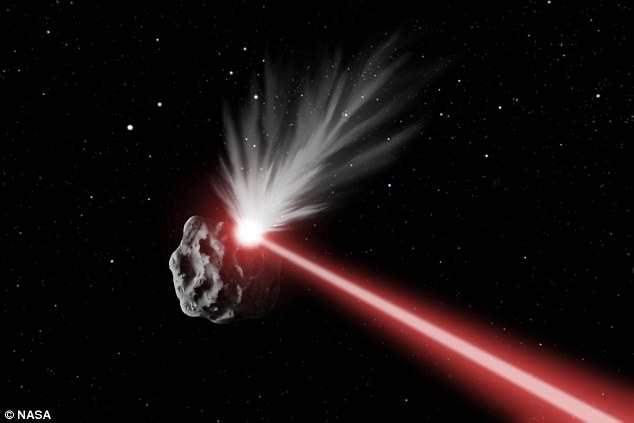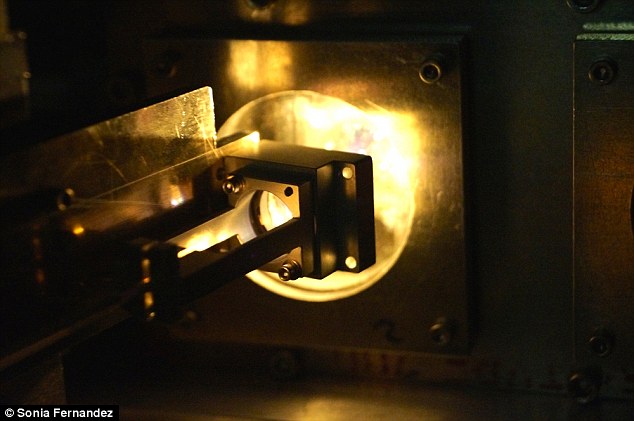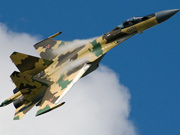

Scientists are building the ultimate science-fiction weapon to deal with asteroids.
A system known as DE-STAR - or Directed Energy System for Targeting of Asteroids and exploRation - will use laser beams to intercept and deflect space rocks.
The concept has been around for several years, but a new paper is now presenting it as a viable solution to ward off dangerous 'Near Earth Objects' (NEOs).

Scientists are building the ultimate science-fiction weapon to deal with asteroids. A system known as DE-STAR - or Directed Energy System for Targeting of Asteroids and exploRation - will use laser beams to intercept and deflect space rocks.
The system is the brainchild of UC Santa Barbara physicist Philip Lubin and Gary Hughes, a researcher and professor at California Polytechnic State University, San Luis Obispo.
Another, smaller system, is also being developed, called DE-STARLITE.
Researchers envision this travelling alongside the hazardous asteroid and gradually deflecting it over a longer period of time.
'Generally speaking, the technology is available today. Qicheng Zhang of the University of California, Santa Barbara, one of the authors of the project, told Astrowatch.net.
'The main challenge with building a full DE-STAR is the necessary scale to be effective.'
In a paper published this year in the journal Earth and Planetary Astrophysics, Zhang explains how lasers could move or vapourise an asteroid on a collision course with Earth.
He says an orbital planetary defense system could heat asteroids to the point of vapourise.

The left concept diagram shows an orbiting DE-STAR engaged in multiple tasks including asteroid diversion, composition analysis, and long-range spacecraft power and propulsion. The right image is an artist's impression of a laser beam vapourising an asteroid.

To simulate a laser's ability to deflect an asteroid, researchers directed a laser onto the target until it glowed white hot, producing a 'rocket engine' using the asteroid itself as the propellant.
When they begin ejecting material, a reactionary force will move them out of their existing path.
Astrowatch.net says if DE-STAR had a 330-feet-wide laser array, it could divert asteroids 330 feet in diameter from a distance of about about two million miles.
Meanwhile, a 20 kW version of DE-STARLITE operating for 15 years could deflect an 1,000ft asteroid at a distance of 8,000 miles.
Last year, researchers revealed the system working in the lab - albeit on a smaller scale.
To simulate a laser's ability to deflect an asteroid, Travis Brashears, a student at the University of California-Berkeley, led a group of students in tests that simulate space conditions.
Using basalt, the composition of which is similar to known asteroids, they directed a laser onto the basalt target until it glowed white hot, a process called laser ablation, which erodes material from the sample.
This changes the object's mass and produces a 'rocket engine' using the asteroid itself as the propellant.
In space, this would be powerful enough to alter its course.
'What happens is a process called sublimation or vaporization, which turns a solid or liquid into a gas,' explained Brashears, now a freshman at UC Berkeley who started working in the lab during high school as part of UCSB's Research Mentorship Program.
'That gas causes a plume cloud — mass ejection — which generates an opposite and equal reaction or thrust — and that's what we measure.'
Then the team simulated a spinning asteroid using basalt to determine whether they could slow, stop and change its rotation direction.
They used magnets to spin the basalt and then directed the laser in the opposite direction to slow the rotation.

Another, smaller system, called DE-STARLITE, is also under consideration. Researchers envision this travelling alongside the hazardous asteroid and gradually deflecting it over a longer period of time.
'Our video shows the basalt sample slowing down, stopping and changing direction and then spinning up again,' said Brashears.
'That's how much force we're getting.
'It's a nice way to show this process and to demonstrate that de-spinning an asteroid is actually possible as predicted in our papers.'
According to Lubin, a professor of physics at UCSB, manipulating the speed of a spinning asteroid offers another important possibility in space: the ability to explore, capture and mine asteroids.
This is something Nasa aims to do with its Asteroid Redirect Mission.
The mission — which remains theoretical — is intended to visit a large near-Earth asteroid, collect and return a boulder from its surface and possibly redirect the asteroid into a stable orbit around the moon.
'All asteroids rotate; it's just a question of relative to whom and how fast,' explained Lubin.
'To mine an asteroid, it needs to be moving slowly enough so you can capture it.
'Our lab experiments show very graphically a practical way to de-spin or redirect an asteroid. It's a vivid demonstration that the technique works very well.'
The DE-STAR system could be leveraged for many other uses, such as stopping the rotation of a spinning asteroid and achieving relativistic propulsion, the team say.

Using basalt, the composition of which is similar to known asteroids, they directed a laser onto the basalt target until it glowed white hot, a process called laser ablation, which erodes material from the sample.
In addition, the students explored photon propulsion, which is key to the group's latest project, DEEP-IN, or Directed Energy Propulsion for Interstellar exploratioN.
The DEEP-IN concept relies on photon propulsion, whereby thrust from photons emitted from the laser array could be used to propel a spacecraft.
This allows for the possibility of relativistic flight — speeds approaching the speed of light — for the small spacecraft required for future interstellar missions.
The team also tested a photon recycler, a device that reuses photons from the laser by shining them on a reflector cavity.
'We have a second mirror at some distance away that bounces the photons back and forth like a ping-pong ball onto the spacecraft reflector.' Brashears said.
'In effect, we're recycling these photons to achieve a force multiplication that allows the vehicle to go even faster.
'So far, with a simple implementation, we have achieved an amplification factor of five. Much more is possible with refinement.
'This works as predicted, though implementing it into the full flight system will be complex.'

The basalt is mounted on a torsion balance to hold it steady for the laser. Asteroid Deflection: Science Fiction or Reality.
Day|Week

 Qiandaohu supply ship named 'model ship' by PLA Navy
Qiandaohu supply ship named 'model ship' by PLA Navy Stunning Kuche on the Silk Road
Stunning Kuche on the Silk Road Tunisian man creates art of sand in Hangzhou
Tunisian man creates art of sand in Hangzhou Goddess teacher shares fitness program online
Goddess teacher shares fitness program online Getting close to PLA's easternmost post on the mainland
Getting close to PLA's easternmost post on the mainland 'Naked run' race held in Beijing
'Naked run' race held in Beijing Train Attendant Recruitment Held in East China
Train Attendant Recruitment Held in East China In pics: Russia's Su-35 fighter jets
In pics: Russia's Su-35 fighter jets Young monks learn kungfu in NE China temple
Young monks learn kungfu in NE China temple Scenery of Guzhu, thousand-year-old ancient village in E China
Scenery of Guzhu, thousand-year-old ancient village in E China